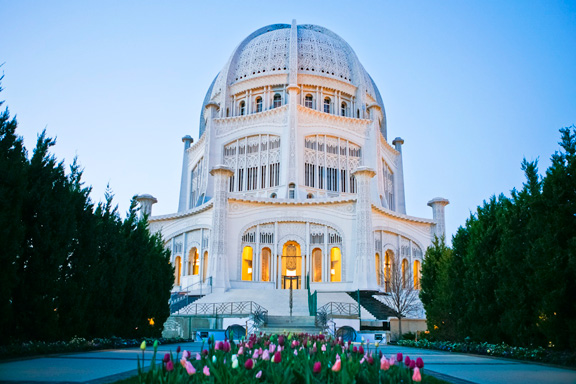The Baha’i House of Worship, also known as the Mashriqu’l-Adhkár, stands as a monumental embodiment of the Baha’i teachings, illustrating the profound interconnectedness of prayer and action. This sacred edifice, located in Wilmette, Illinois, serves not merely as a place of worship but as a vibrant nexus for spiritual and community engagement. The unique architecture and purposeful design mirror the principles that underpin Baha’i faith, including unity, service, and the harmonization of spirituality with social action.
At first glance, the Baha’i House of Worship evokes an air of tranquility and reverence. Visitors are often struck by its octagonal structure, adorned with intricate ornamentation that symbolizes divine attributes. The design not only captures aesthetic beauty but also serves a dual function by fostering communion among individuals from diverse backgrounds. This synthesis of architectural elegance with spiritual philosophy powerfully illustrates a central tenet of Baha’i teachings: the oneness of humanity.
Within the structure, spaces for devotional gatherings and individual reflection are seamlessly interwoven. The design encourages collective worship, resonating with the Baha’i emphasis on community. Here, individuals can engage in prayer, study, and contemplative practices, aiding their spiritual growth while contributing to the collective consciousness of the community. Thus, the House of Worship becomes a crucible for spiritual rejuvenation and social action, inviting adherents and seekers alike to embark on a journey of inner transformation.
The concept of prayer within Baha’i doctrine transcends mere supplications for personal needs. Instead, it embodies a holistic approach to aligning oneself with divine will. Prayer is an innate human response to the quest for understanding and connection, fostering a sense of inner peace and spiritual clarity. The Baha’i teachings advocate for the power of collective prayer, demonstrating that when individuals unite their intentions in a sacred space, the potential for collective impact is magnified.
Yet, one cannot detach prayer from the imperatives of action in Baha’i belief. This symbiotic relationship reveals an underlying truth: genuine spirituality must manifest in tangible humanitarian efforts. The synthesis of prayer and action underscores the importance of service as a societal obligation. Baha’is are encouraged to channel the spiritual insights gained through prayer into concrete actions that elevate the community and alleviate the suffering of others. This dual focus manifests the Baha’i vision of a global society characterized by equity and compassion.
The principle of ‘Synergy of Prayer and Action’ is, therefore, a profound observation in the teachings of Baha’u’llah, the founder of the Baha’i Faith. The teachings suggest that prayer without action is incomplete; equally, action devoid of spiritual foundation risks devolving into mere activism. The Baha’i House of Worship exemplifies this balance, operating as a hub for activities that promote social betterment as an extension of spiritual engagement. From educational programs to social justice advocacy, the House of Worship serves as a catalyst for demonstrating the transformative power of prayer in a physical context.
A fascinating aspect of the Baha’i House of Worship is its international appeal, functioning as a pilgrimage site for individuals spanning diverse cultural and spiritual backgrounds. This draws attention to a critical observation: the human yearning for spiritual connection transcends geographic and ideological boundaries. When individuals congregate in this sacred space, they partake in an unspoken dialogue about the fundamental principles of existence and purpose. Each prayer uttered, each action taken within its walls, resonates with the collective aspiration for unity and understanding.
Furthermore, the underlying architecture of the Baha’i House of Worship serves a symbolic purpose reminiscent of the multifaceted nature of human spirituality. The building’s nine sides and corresponding gardens reflect the principle of harmony between humanity and nature, reinforcing the Baha’i perspective on environmental stewardship. In this way, the House of Worship not only draws people together for spiritual rites but also inspires ecological awareness, embodying a proactive approach to environmental responsibility in its design and function.
Moreover, the House of Worship is underscored by the principle of inclusivity—everyone, regardless of faith or background, is invited to enter and partake in its offerings. This open-door policy becomes emblematic of the Baha’i commitment to unity in diversity, promoting dialogue and participation from all walks of life. Such inclusivity enriches the experience of both prayer and action, fostering an environment where every voice contributes to the collective harmony.
In summation, the Baha’i House of Worship stands not merely as a structure of devotion but as a profound representation of the Baha’i teachings on the unifying forces of prayer and action. It invites individuals to transcend individualism and embrace the communal aspects of faith through collective worship and altruistic endeavors. The intricate architecture, coupled with the multifarious programs hosted within its walls, underpins its role as a transformational space, urging adherents to engage deeply with their spiritual journeys while making substantive contributions to the world. Thus, the House of Worship functions as a beacon of hope, where the aspirations of the faithful converge in the pursuit of a more just and united humanity.
